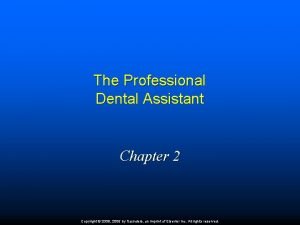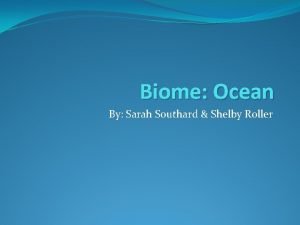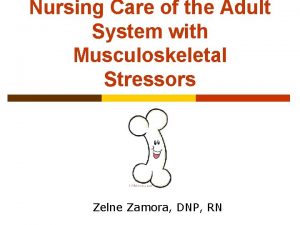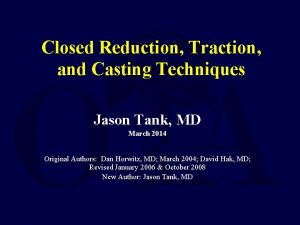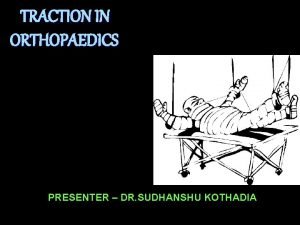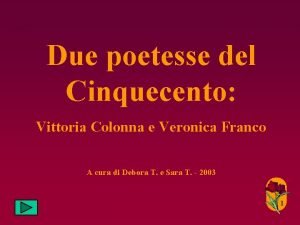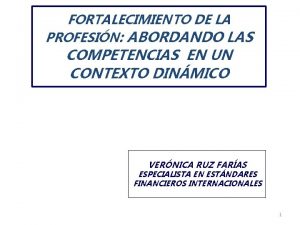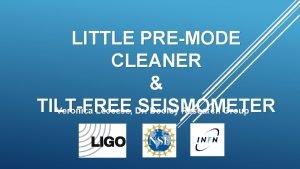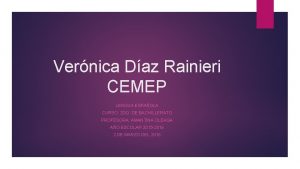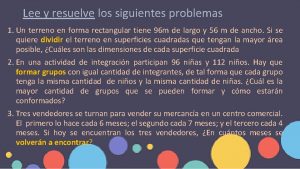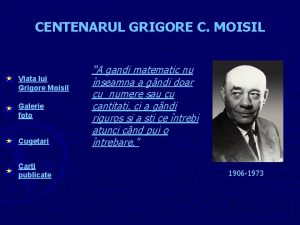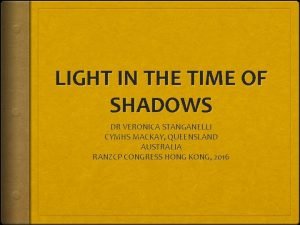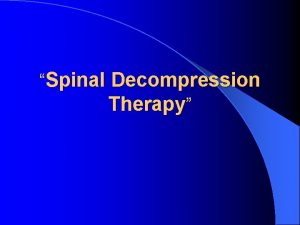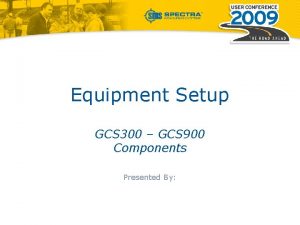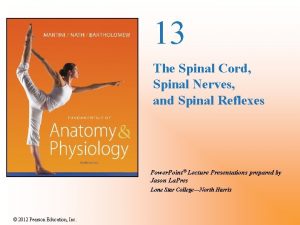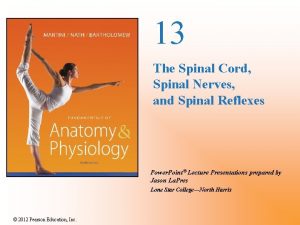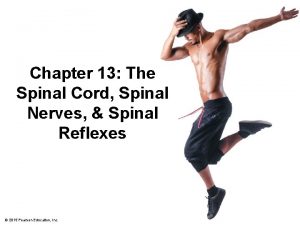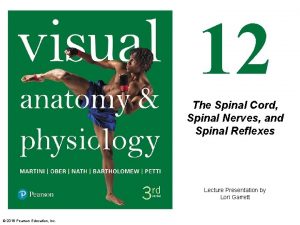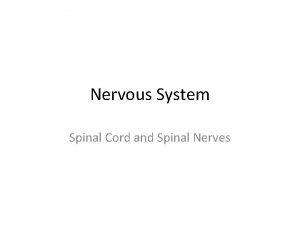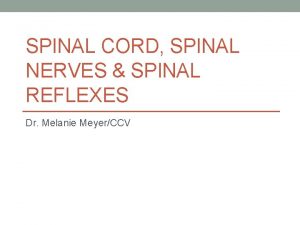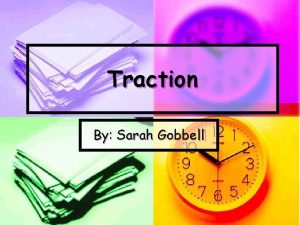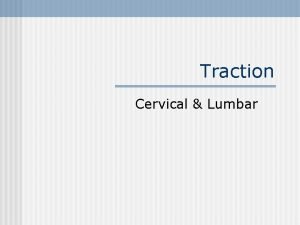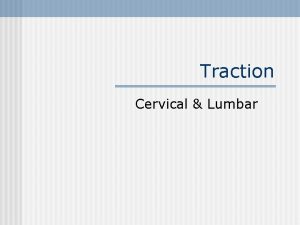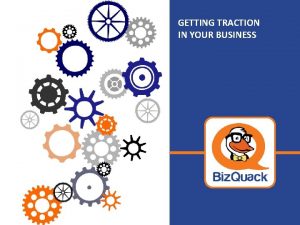Mechanical Spinal Traction Veronica Southard PT MS GCS




















- Slides: 20

Mechanical Spinal Traction Veronica Southard PT MS GCS

Spinal Traction l l Electronic units Pulling forces Longitudinal separation and gliding C or L segments or lengthening of soft tissues There are several types of traction including; con’t bed traction, manual traction, Auto traction, Positional traction and Mechanical traction

Goal l l Reduction of signs or symptoms of C or L spinal compression Utilize maximal traction with minimal force

Physical Effects of Traction l Gentle stretch to joint capsule – Dependent upon the angle of pull and position of the spinal segments

Effects Con’t l l Increased inferior-superior dimensions of the intervertebral foramina Elongation of posterior muscular tissues Improved blood supply to posterior soft tissue and intervertebral discs Altered intradiscal pressure

Indications l Musculoskeletal signs: – – – Decreased sensation, motor function or reflexes, that are temporarily reduced with manual traction General hypomobility of spine Local spinal hypomobility and associated increased muscle tone that reduces with manual or positional traction

Indications con’t l Musculoskeletal symptoms: – – Numbness of extremity, pain, tingling that is temporarily relieved by manual or positional traction. Central, unilateral or bilateral spinal pain reduced by manual or positional traction

Common Indications l l l Spinal nerve root impingement due to DDD Intradiscal pressure if treatment is 10 minutes or less. Spinal nerve root impingement due to stenosis. Vertebral body separation, typically in a flexed direction Generalized of hypomobility of L & C spine M spasm resulting in nerve root impingement

Contraindications l Absolute – – – 1. Spinal infections 2. Spinal Ca 3. Spinal Cord pressure 4. RA 5. Osteoporosis

Contraindications: Relative l l l Ligamentous strains and hypermobility Acute stage of injury Traction anxiety Cardiac or respiratory insufficiency Pregnancy

Patient instruction l l Explain to patient Position Pt. – – C spine can be done in sitting or supine. Supine provides increased relaxation, vertebral separation and easier countertraction L traction can be done supine or prone

Angle of Pull l Angle of Pull – C spine Occiput ( C 1 -C 2) 0 -5 degrees flexion l l Mid. Cervical (C 2 -C 5) 10 -20 flexion Low cervical (C 5 -C 7) 25 -30 flexion

Intervertebral Encroachment l l Flex, and SB toward unaffected side and rotation toward affected side Disc- C spine neutral. Want ligaments to be lax and allow better distraction

Lumbar spine l l l Positioning for intervertebral encroachment is neutral for bilateral involvement. Unilateral SB toward good side with trunk rotated toward the affected side. Facets are treated in flexion Position: L 5 -S 1= 45* hip flexion l l L 4 -L 5 = 60 -75* HIP FLEXION L 3 -l 4 + 75 -90* HIP FLEXION

Traction Technique l Angle of pull – – C spine supine better. 25* flexion L spine Flex hip and knees, symmetrical or prone or unilateral technique

Force l l C spine start with 15#, Increase to 25#, Never exceed 50# L spine 25% body weight, up to 50% body weight. Never exceed body weight. Nerve root problems may require only 25 -60#. Start with low force

Mode of treatment l Intermittent Most comfortable – – – On times generally between 7 -20 sec Off times 7 to 60 sec On/Off ratio may be 1: 1 or 3: 1

Static traction l l Used less frequently. Treatment times 8 -25 minutes Brief continuous for disc problems 10 minutes Facet problems 15 -20 minutes

Other duration considerations l l HNP Decrease time 5 -8 minutes DJD, Spondylolithesis up to 20’ Frequency from 2 -3 times per week up to daily Allow the patient to rest a few minutes upon completion. Ask the patient f they have any dizziness or headache post treatment

Document l l l A. Position B. Angle of pull C. Amount of force. , hold and rest cycles D. Static or intermittent E. Duration F. Pt. Response – – Pain / changes Functional changes
 What credential is issued by the danb
What credential is issued by the danb Sarah southard
Sarah southard Spinal nerves labeled
Spinal nerves labeled The spinal nerves
The spinal nerves Innervations of the brachial and lumbar enlargements
Innervations of the brachial and lumbar enlargements Spinal cord structure
Spinal cord structure Bucks traction weight
Bucks traction weight Volar slab
Volar slab Fixed and sliding traction
Fixed and sliding traction Actual mechanical advantage vs ideal mechanical advantage
Actual mechanical advantage vs ideal mechanical advantage Vittoria colonna biografia
Vittoria colonna biografia Forensic dentistry definition
Forensic dentistry definition Veronica ruz farias
Veronica ruz farias Premode
Premode Veronica diaz rainieri
Veronica diaz rainieri Lee los siguientes problemas y resolverlos
Lee los siguientes problemas y resolverlos Ecuatia moisil
Ecuatia moisil Dr veronica mckinney
Dr veronica mckinney Veronica gallardo ospi
Veronica gallardo ospi Veronica ginocchio
Veronica ginocchio Dr stanganelli
Dr stanganelli
